
This is the Jefferson Memorial shortly after dusk. It’s a soft composite of two different exposures, one to capture the building and one to capture the sky and water. I’m sure Jefferson would be pleased.



This is the Jefferson Memorial shortly after dusk. It’s a soft composite of two different exposures, one to capture the building and one to capture the sky and water. I’m sure Jefferson would be pleased.


Did President Trump seriously pull an “I have in my hand…” today in front of reporters? Yes he did:

This is supposedly the “secret agreement” he has with Mexico in addition to the actual agreement that was made public a couple of days ago. Uh huh.

A couple of years ago, as part of his temper tantrum against Obamacare, Donald Trump decided to eliminate CSR subsidies. Click here for more details about what this means, but the short story is that Trump thought this was a great way to sabotage Obamacare. However, thanks to the details of how this works—which Trump was naturally ignorant of—it turned out to be a net positive that increased Obamacare subsidies by nearly $200 billion over ten years. Nice work, Donald!
Two years have now gone by, and Andrew Sprung has recently been diving into the whole issue of “silver loading”—i.e., the insurance industry response to the loss of CSR subsidies—and I’ve been following along but not entirely understanding all the nuts and bolts. Today, however, he writes about whether silver loading affects Obamacare enrollment rates. That looks interesting! Does higher silver loading, which provides more bang for the insurance buck, also increase enrollment? Here’s a state-by-state look:
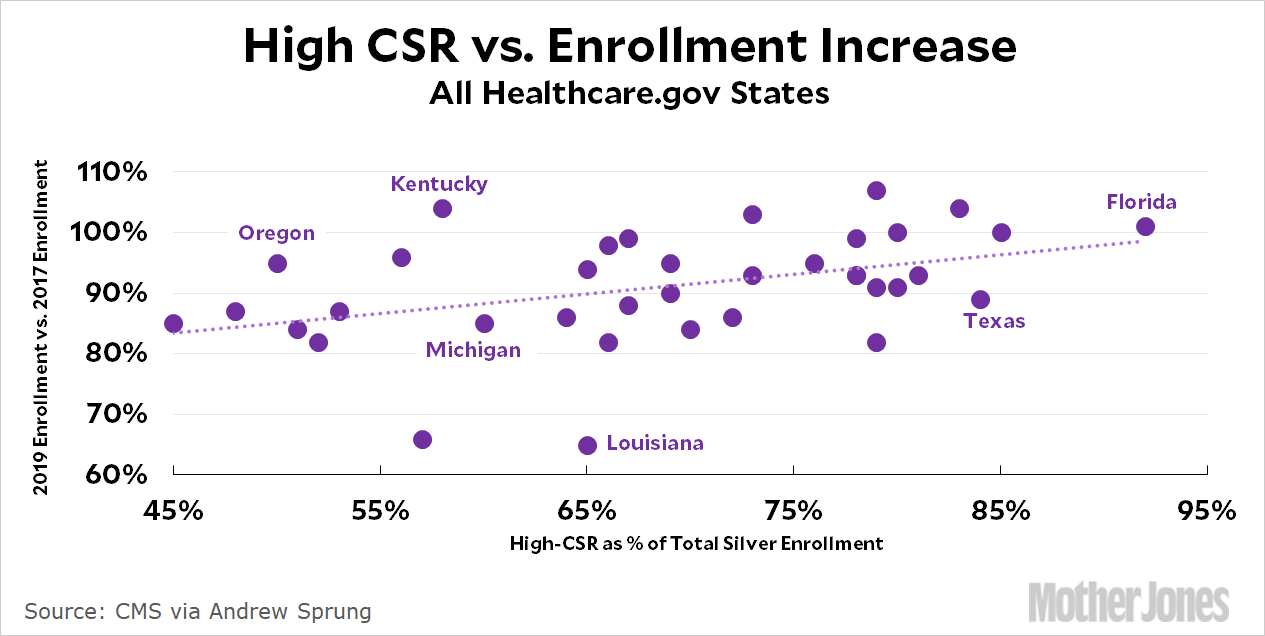
Higher silver loading does indeed increase enrollment. The effect isn’t huge, but as silver loading gets higher, re-enrollment rates also get higher. This is not surprising: when you effectively provide bigger subsidies, which reduces the cost of insurance, more people are likely to enroll. You can click here to read Sprung’s more detailed analysis.
Econ 101 bottom line: if you make something cheaper, more people will buy it. Isn’t that fascinating?
Some life advice from Sam Sanders:
Tip. Tip everybody. Tip the guy who runs your apartment building. Tip your ride share driver. Tip the lady who delivered your food. Tip whoever cleaned your hotel room. Tip the person who changed the oil in your car. Tip your waiter. Tip the host/ess, as well. Always be tippin’!
— Sam Sanders (@samsanders) June 11, 2019
I’ve always been an OK tipper, but in recent years I’ve actively tried to become a more generous tipper. I can easily afford it, and it’s one more (modest) way of helping folks out. It only adds up to a fraction of what most of us give to formal charities, and if everyone did it, it would make a difference. Not the biggest difference in the world, but every little bit helps.
A few days ago Tyler Cowen linked to a study from Denmark about the effect of a new law that adds criminal offenders to a DNA database. The abstract says that the law “reduces recidivism within the following year by as much as 43%,” which I found both impressive and a little scary. Impressive because that’s a big result. Scary because it points the way toward an ever more efficient surveillance society.
But once I plowed through the paper and finally understood all the different tables,¹ I’m a little less impressed by the power of DNA registration. First, here’s a chart showing the general approach that the authors took:
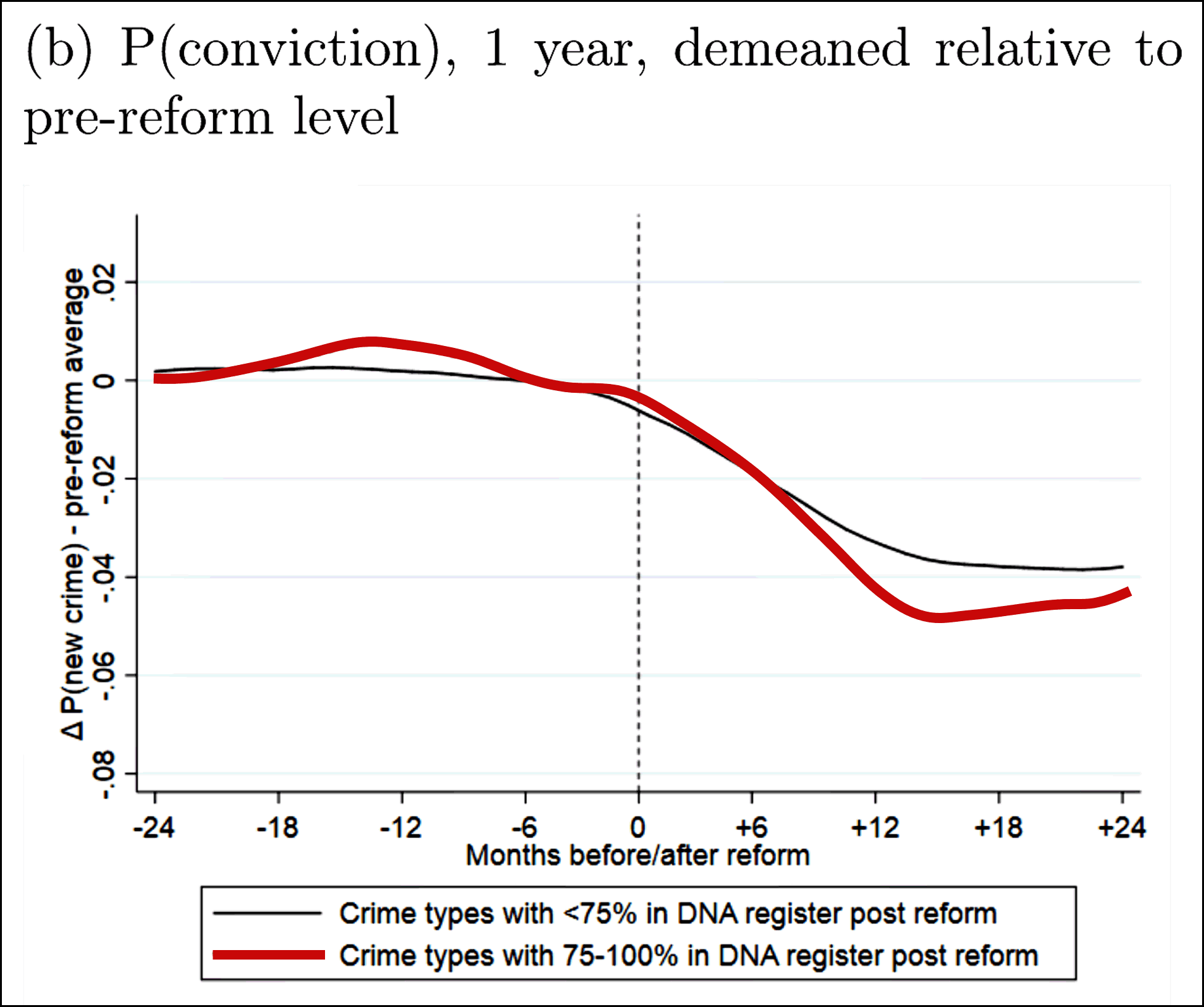
The general idea is simple: some crimes are more likely to get you into the DNA register than others. As this chart shows, after 12 months the probability of committing a new crime is lower among those who knew for sure that their DNA was now registered. Here’s a chart showing the actual reduction in recidivism for various crime types:
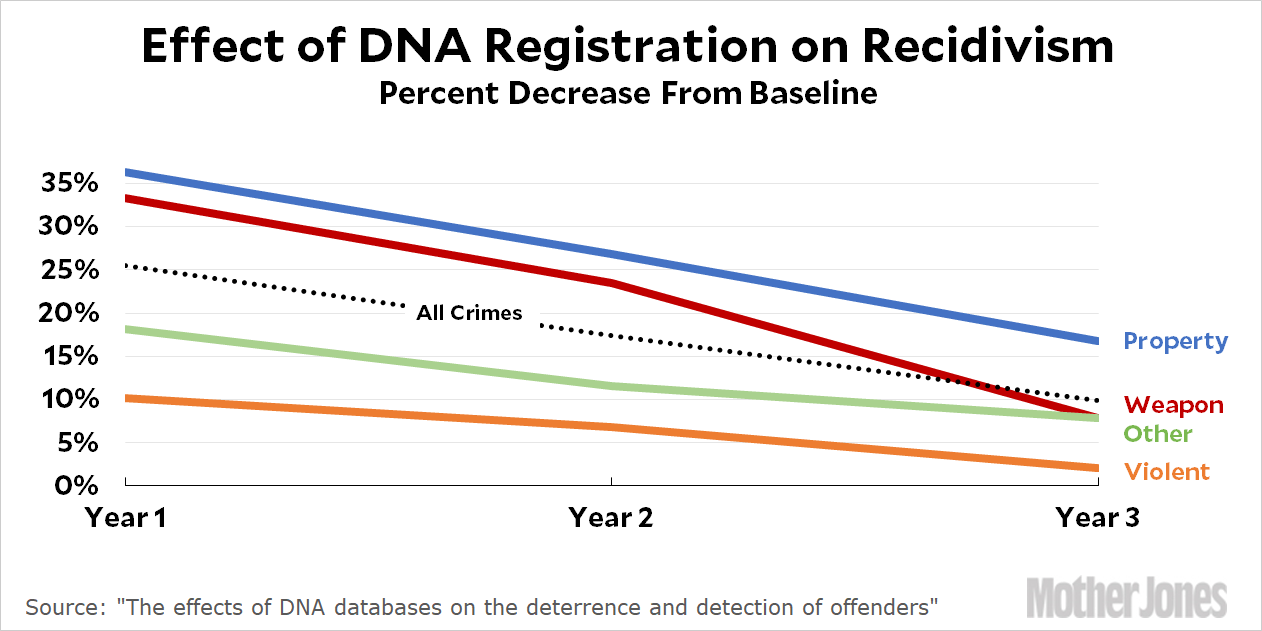
The most obvious result here is that the effect on recidivism is fairly high during the first year, but steadily decreases after that. By the third year, the effect on property crimes remains significant but the effect on other crimes is fairly modest, and on violent crimes has shrunk to only 2 percent. The reduction in committing any crime was about 10 percent by year three.
Now, 10 percent isn’t nothing, but it’s not huge either. I would certainly like to see studies of other countries that have done this, as well as a follow-up study in Denmark a few years from now to see if the effect lasts.
¹Thanks to co-author Anne Sofie Tegner Anker for helping me out with this.
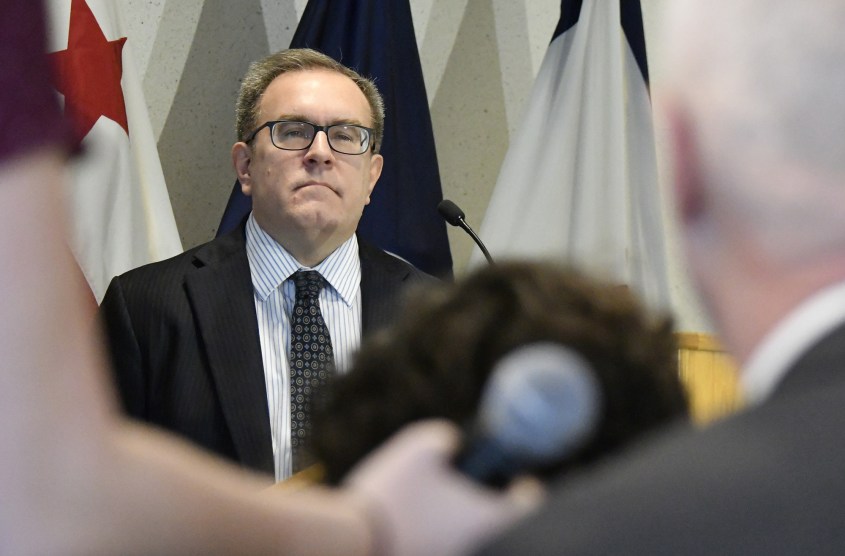
Bastiaan Slabbers/NurPhoto via ZUMA
In most studies of new drugs, half the patients are given the experimental drug and the other half are given a placebo. It’s a “blinded” study because the patients don’t know which they’ve been given. In a double-blinded study, the doctors don’t know either. Andrew Wheeler, head of the EPA, is a wee bit confused about this:
FDA routinely uses the double-blind scientific studies for their work where they have two teams of researchers replicating the same data, both teams don’t know each other exist and where they are. We don’t do that at the agency, we don’t do that across the entire federal government. I’ve believed for a long time that federal research would be more accepted by the public if you used the double-blind standard for everything.
Is Wheeler really this dumb, or was this deliberate? Trump’s EPA has been pushing the idea that we should have a “red-team-blue-team” approach to studying climate change, where the red team would be made up of skeptics. By pretending that this is what researchers mean by a double-blinded study, Wheeler is making it seem as if this approach would be nothing more than adopting best practices for scientific work. In reality, it’s just an excuse to put together a team of cranks on the taxpayer’s dime.
This is the latest example of “stupid or evil?” As always, it could be either. Or both. But this time I’m guessing evil. Wheeler’s “mistake” is a little too pat and a little too redolent of his mentor, Sen. James Inhofe, Congress’s lead climate change denier. His old boss must be proud.
Tonight Joe Biden repeated something he’s said before:
Biden at a fundraiser tonight, on his desire to work with the Republican Party post Trump.
“With Trump gone you’re going to begin to see things change. Because these folks know better. They know this isn’t what they’re supposed to be doing.”
— Sam Stein (@samstein) June 11, 2019
Josh Marshall is shaking his damn head:
I fear/sense that at a core level this is true. https://t.co/7uvATE2Q8p
— Josh Marshall (@joshtpm) June 11, 2019
This is an example of something that’s sort of amused me for a long time. If you ask people about politicians, you’ll almost invariably hear nothing but cynicism. They lie constantly. They tell people what they want to hear. They flip-flop. They say different things to different audiences. They’re always repeating talking points. Etc.
And yet, in real life, most people take politicians at 100 percent face value: if they say something that’s not obviously preposterous, we simply accept it. Cynicism goes straight out the window. (Unless it’s someone whose guts we hate. Then everything they say is automatically a lie.)
I have no idea what Joe Biden “really” believes about working with Republicans. But I will say this: he’s a politician. There’s zero reason to think he truly believes what he’s saying here. There’s also zero reason to think he doesn’t believe it. The fact that he said it is simply a null input.
At the same time, Biden isn’t an idiot. Of course he knows what the modern Republican Party is like. But like Obama before him, he also knows that lots of people really like to hear paeans to bipartisanship. We political junkies may hate it, but ordinary people who don’t inhale cable news are suckers for the idea that we can all get along if we just give it a try—and there are way more of them than there are of us. Biden knows this, so that’s what he tells people. Whether he really believes it or not matters not a whit.
Bastiaan Slabbers/NurPhoto via ZUMA
Over on Twitter, someone suggested taking a look at early polls of the Iowa caucuses from past years to see how they panned out. On the Democratic side, it’s a little tricky because there were really only two candidates in 2016 and one of them was the clear frontrunner. That’s not much of a comparison to this year, so I went back to 2008:
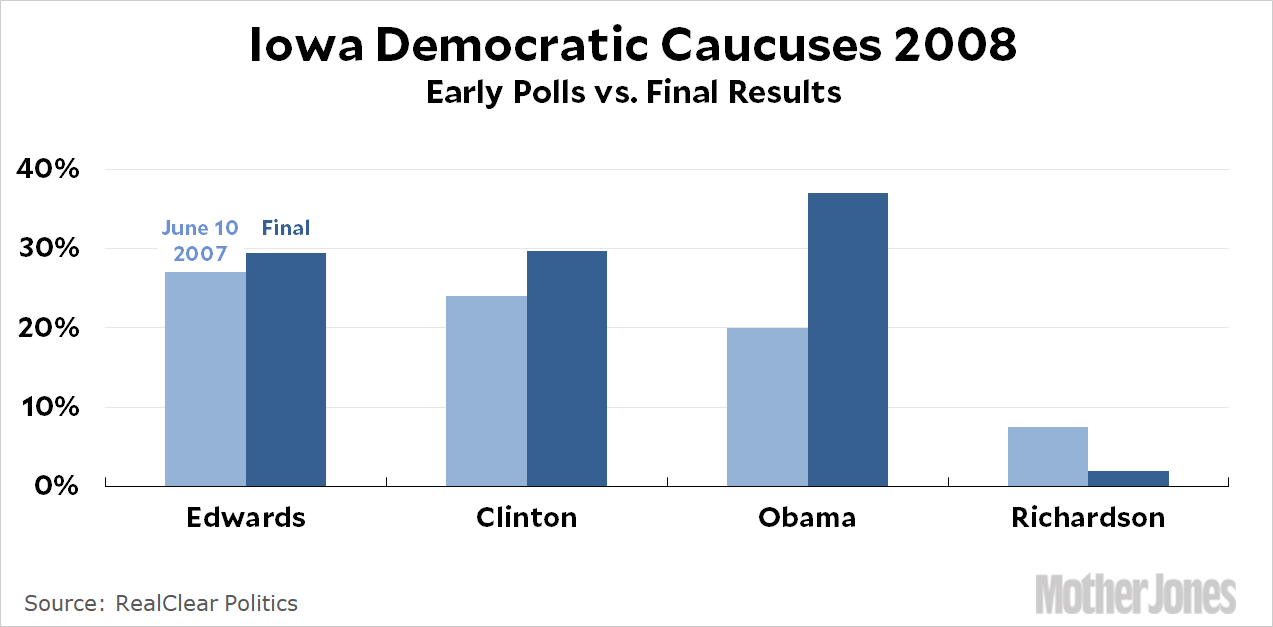
Support for John Edwards (remember him?) and Hillary Clinton stayed pretty steady during the entire campaign, while 3rd-place candidate Barack Obama quietly scooped up nearly all of the undecided vote and ended up winning by a wide margin.
On the Republican side, 2016 featured a huge number of candidates, which makes it a pretty good comparison for Democrats this year. Here are the top ten candidates on June 10 before the caucus date:
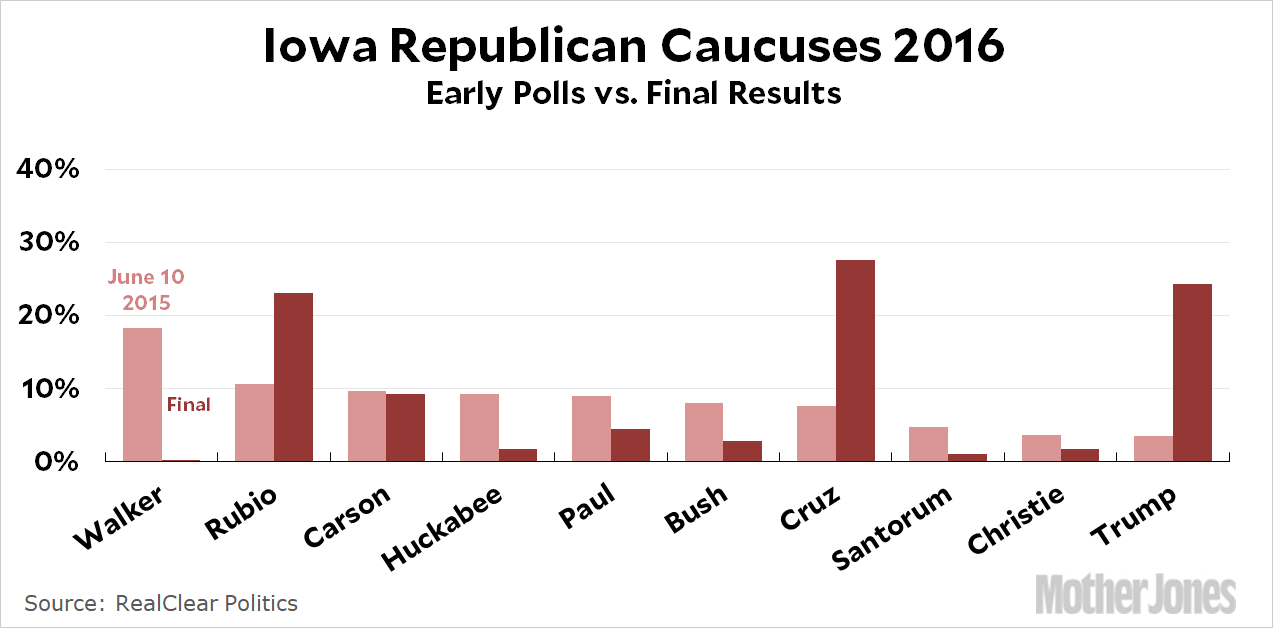
This is even better news for today’s also-rans. The early leader, Scott Walker, wasn’t even in the race by the time the caucuses were held, while seventh-place Ted Cruz won and tenth-place Donald Trump came in a close second.
I think the only real lesson you can take away from this is that you’re in trouble if you aren’t even managing, say, 5 percent support right now.¹ For what it’s worth, RCP has only five candidates currently polling above that level:
This looks . . . about right to me. Maybe add Cory Booker and Amy Klobuchar as dark horses, and I think that’s pretty much the field.
¹As usual, Donald Trump is a huge outlier.

Elaine Chao and friends.Shealah Craighead via ZUMA
At the Department of Transportation, projects are doled out based on formulas and metrics that treat every state equally. But it turns out that some states are more equal than others. You see, the secretary of transportation, Elaine Chao, is married to Senate Majority Leader Sen. Mitch McConnell, who is running for reelection next year in Kentucky. So she asked her chief of staff to pay special attention to the state’s needs and act as liaison:
Chao’s aide Todd Inman, who stated in an email to McConnell’s Senate office that Chao had personally asked him to serve as an intermediary, helped advise the senator and local Kentucky officials on grants with special significance for McConnell….He also discussed the project by phone with Al Mattingly, the chief executive of Daviess County, which includes Owensboro, who suggested Inman was instrumental in the process.
….“Todd probably smoothed the way, I mean, you know, used his influence,” Mattingly said in a Politico interview….“Well, let’s put it this way: I only have her ear an hour when I go to visit her once a year,” he added of Chao and Inman, a longtime Bluegrass State operative who had worked as McConnell’s advance man. “With a local guy, he has her ear 24 hours a day, seven days a week. You tell me.”
“You tell me” indeed. That’s some mighty good swamp draining going on in the Trump cabinet.

My mother curated today’s photo, a friendly-looking mountain goat at our local zoo. He’s in the petting zoo area, and I gather that he’s accustomed to getting snacks from passers-by, which probably accounts for the friendly look.
